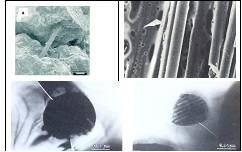
Jesús Ma Rincon
Instituto de Ciencias de la Construcción Eduardo Torroja, Spain
Title: Glass-ceramic composites from the extrinsic to the intrinsic point of view
Biography
Biography: Jesús Ma Rincon
Abstract
Composite material is a production field that reached, already in the last century, its full development in science, technology and market applications. At the starting of composites materials research, usually only those materials that are composed by a dispersed material into a continuous matrix were considered as “actual composites”. However , this concept has evolved more in recent decades, due to the capability to precipitate into a matrix for internal thermal processing or phase transformations of several heterogeneous shaped materials into several matrices and/or respectively; that is the case of the glasses and glass-ceramic composites. Thus, inside the “non-metal or inorganic composites”, both glasses and glass-ceramics which have given rise to the fine or advanced ceramics, the “glass-ceramic composites” can be considered such as composites. To this respect, there are two ways for considering composites in this research: a). The extrinsic, more traditional composites, by embedding a phase into another phase or b) to promote the phase transformation into a glassy or vitreous phase for precipitating very small crystallites (even nanocrystals) into the glass, giving rise to an “intrinsic glass-ceramic composite”. Some of researches carried out in last decades of the author in this type of composites are reviewed and possibilities for applications for this material are discussed. In fact, this wide family of composites can be very useful for construction or for industrial applications. Even more, in recent years, the “composite concept” for materials and for processes are emerging as one promising solution for using this technology to immobilize some radioactive wastes into composite glass-ceramic matrices with long term stability.

Figure 1: Micrographs from several inorganic composites:
a) FPP fibers in CSH matrix (SEM);
b) SiC fibers in basalt GC (SEM) c) ZrO2 in mullite sintered glass- ceramic (TEM)
Recent Publications :
- Callejas, J. Rubio, J. Ma. Rincón, J.L. Oteo (1990), Estudio previo de materiales compuestos a base de basaltos reforzados con fibras de CSi (NICALON). In: Ciencia y Tecnología de los Materiales Cerámicos y Vítreos, España’89, Castellón, Ed. Faenza Editrice Ibérica, SL., pp: 79-84
- Cáceres,J.M., J. E. García- Hernández y J. Ma. Rincón (1996). Characterization of fibers as rockwool for insulation obtained from canary islands basalts. Mater. Construcc. 46 , 242-243: 61-78
- Rincón , J.Ma. (2002). Glasses, glazes and glass-ceramics at the starting of the millennium. Key Engineering Material 206-213, 2: 2039-2044
- García Santos , A., J. Ma. Rincón, Talero, R. (2005). Characterization of a polypropilene fibered cement composite using ESEM, FESEM and mechanical testing. Constr. Build. Mater. 19 : 396-403
- Rincón,J.Ma. M. Romero, Mª. S. Hernández- Crespo, R. Talero, García-Santos,A. ESEM and EDS microanálisis in a FPP/ cement matrix composite, In: Science and Technology of Composite Materiales COMATCOMP-09, Eds. A. Güemes et al., San Sebastian., Vol 1 . 399-402


